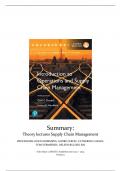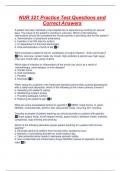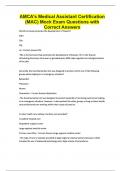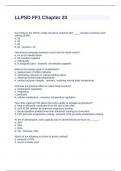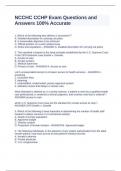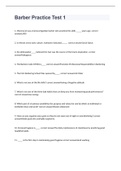Theory lectures Supply Chain Management
PROFESSORS: KOEN MOMMENS, ANDRÉ CERON, CATHERINE CASSAN,
TOM VERMEIREN, HELEEN BULDEO RAI
Gino Aytas | 2MA IB | Academic year 2022 – 2023
Version 1
,Practical information:
The final grade is composed out of a written closed book exam for 100% of the mark. The
exam consists out of both open questions and multiple choice questions as well as exercises.
The formula sheet used during the WPO sessions can be used on the exam.
1. Lecture 1: Introduction and Warehouse Management
1.1. INTRODUCTION TO SUPPLY CHAIN MANAGEMENT
A supply chain is a network of activities to deliver finished products to customers. This
chain starts at the very beginning with raw materials and ends with the customer receiving
a finished good:
• Suppliers: Provide raw materials and components
• Manufacturer: Transforms materials into finished products
• Distributor: Distributes products to distribution centres or wholesalers
• Retailer: Sells product to end customer
This description is quite a oversimplification, in practice it can be a bit more complicated.
In this picture we see a more complex supply chain. Generally supply chains go from left
to right, with the exception of for example faulty goods that are being returned.
Taking the factory in the middle as our starting point, we see that they have actors
upstream (inbound) and downstream. Inbound to the factory are raw materials from the
supplier. This supplier is called tier 1 as it is where we get our materials from directly,
however further down the chain it is possible that our tier 1 supplier obtains materials from
another supplier. That supplier will become tier 2, tier 3 and so on.
Once the factory transforms the raw materials into finished products they are distributed
to a distributor/wholesaler from where they travel to the store. A wholesaler distributes
PAGE 1
,finished products without a brand preference. Distributing goods from all types of brands.
While a distributor only distributes a particular brand. Finally at the store the goods are
available for end customers to purchase. Nowadays the store is sometimes eliminated in
the chain when manufacturers sell directly to customers (ex. e-commerce). Sometimes
before or after the factory warehouses are part of the chain. A lot of the activities in the
supply chain are outsourced and done by a third party, for example the delivery or
warehouse storage.
Most crucial throughout the entire supply chain is information between the actors. How
many goods should be kept in stock at different places in the supply chain, what supplier
should be asked to deliver raw materials, and so on.
Supply chain management (SCM) is the business that coordinates the entire supply
chain:
• Goods: From suppliers to customers
• Information sharing with actors
o Sales forecasts, sales data,
o Inventory levels
o Ex. When a store has a promotion more products will be needed
• Goal
o Maximize customer value
o Achieve competitive advantage
Lets look at an example of
such supply chain in action
for Nike. The company
produces its goods in
factories in Asian countries.
The goods from the
factories are consolidated
in consolidation centres,
where they are put onto
trucks, barges and trains to
a port of origin.
From there onwards they are brought to port of destinations all over the world.
Specifically for Belgium, once they arrive at the port of Antwerp, they are put on an inlands
waterway ship to the European Distribution Center (DC) in Laakdal. From the DC
onwards last mile delivery towards stores is facilitated across Europe.
PAGE 2
, A question one might ask is: does it
make sense to transport goods all
over the world? Yes it does, due to
economics of scale. Big ships can
ship enormous amounts of containers
quite cheaply across the globe.
Additionally standardized containers
are used, making it relatively easy to
work with them.
The term TEU is used to indicate capacity of containers, the higher it is the more containers
there are. Over time the volume of containers across all European ports has increased
significantly. 1 TEU = 20 foot container
Due to these economies of scale it has gotten cheaper over time as ship capacity increased.
This graph shows the USD per TEU as a function of ship TEU capacity for Singapore to
Rotterdam.
At this scale it only costs around 150 USD to ship one container, which is quite cheap
compared to the alternatives. One of those alternatives would be to transport them by air
or land, which is in most instances more expensive.
PAGE 3

